Beyond the Economic Ties: EU in the Chinese Media
[View PDF]
By Xinru Ma
Introduction
The European Commission first set out its strategy for EU-China relations in the 1995 Communication “A Long Term Policy for China-Europe Relations” (European Commission 1995). Since then, the EU has changed dramatically – as have China and the global political and economic environment. Economic development has transformed China’s global position with implications for the world’s economy, especially for that of the United States and the EU, which have significant financial and trade interdependence with China.
The EU’s current policy towards China is based on the October 2006 Commission strategy: “EU-China: Closer Partners, Growing Responsibilities” (European Commission 2006). According to the Commission’s website, the main objectives of the EU policy towards China are to:
- Extend dialogue with China, both bilaterally and on the world stage, working together on global challenges such as climate change;
- Support China’s transition to an open society based upon the rule of law and respect for human rights;
- Encourage the integration of China into the world economy and trading system, and support economic and social reforms; and
- Raise the EU’s profile in China, to aid mutual understanding.
Based on these objectives, EU-China relations have been framed under three main headings: political dialogue (including a specific dialogue on human rights); economic and trade relations and lastly, the EU-China cooperation program.
Among these three domains, Chinese discourse regarding the EU has concentrated mainly on the promotion of trade, bi-regional dialogue, as well as programs on economic, commercial and development cooperation. Recently, security and political cooperation have been added on a limited scale to widen the spectrum of EU–Asia relations. However, during my research, it is evident that extremely few studies have ever been conducted on the Chinese perceptions of the EU, as well as on the media’s role in providing the public with information about the EU and in shaping EU-related foreign policies.
This paper seeks to fill this gap by examining how the EU is portrayed in Chinese media and by comparing the real EU in Chinese media and the views and aspirations of the EU Commission. Key questions to be addressed are listed as follows:
What are the most mentioned images of the EU in China?
- Is the EU in China a recognizable actor, both politically and economically?
- Is the EU or its member states more likely to be seen as partners for China?
- How important is the EU to China when compared to the U.S. and other neighboring nations?
- How are the enlargement process and other internal developments of the EU perceived in China?
- Looking ahead, how would Chinese envision the future of EU-China relationship?
To answer these questions, this paper would first review the EU’s programs in China, which are designed to promote the EU’s profile. Then I will examine the fundamental differences in norms and values between the EU and China, especially the difference in recognition of sovereign right and individual right, the respect for human rights, democracy, and the rule of law, which are inherent to the European integration process and serve as core EU values. Within such context, I will then conduct a media content analysis of the EU news in the Chinese media.
The choice of the media is determined by a consideration of the targeted readership, namely, a popular media (read by a wide audience) and an English-language newspaper (read by the educated and cosmopolitan group of locals to improve their English language skills as well as by foreigners learning about the internal matters from the outside). In viewing this, two national Chinese media would be chosen: Xinhua Net (the most important and official news agency website in China), and China Daily (China’s first and most popular English newspaper). Financial papers and magazines are purposefully excluded to guarantee a broader view of the Chinese perceptions of the EU instead of a narrow focus on the economic ties.
This paper will present the preliminary result of a six-month media content analysis of the daily coverage of the EU from January 1st to June 30th, 2011. This time frame is chosen because 1) politically, the eruption of Libyan civil war in February 2011 served as a good timing for the EU to assert its political role in fomenting world peace and rule of law around the world; 2) socially, 2011, as the EU-China Year of Youth, marks one of EU’s prominent PD efforts to promote intercultural dialogue and strengthen mutual understanding and friendship between European and Chinese youth; 3) economically, both Chinese Premier Wen Jiabao and Vice President Li Keqiang visited Europe and signed big contracts, reasserting the EU’s role as the world’s largest economy.
By examining the volume, sources, focus, neutrality, and news frames of the EU news, this paper hopes to find out how the EU is portrayed in the Chinese media, thus defining the gap between the aspirations of the EU and the actual perceptions of the Chinese community. It also hopes to shed light on the nature of the China-EU strategic partnership, and whether there is real strength underpinning this relationship, besides the obvious trade policies. It will then explore the possibility of ever bridging the perceptions gap given the major differences in regime type, norms, values, and identity that separate the EU and China. In the end, this paper will propose how the EU’s public diplomacy efforts could help to narrow this gap.
Literature Review
The EU and China are increasingly engaged in a multi-faceted relationship across areas that include trade and aid, human rights, security and international cooperation. In fact, the dramatic growth in ties between China and Europe has been referred to as “one of the most important [...] developments in world affairs in recent years” and as “the new axis in world affairs” (Shambaugh 2004: 243). For the then EU Commission President Romano Prodi, “Relations between the EU and China” were “more than just business [...] and we hope to further intensify and expand our policy coordination in this respect ... our relations had never been better.”
This reflects the EU’s objective of trying to move away from a relationship largely based on economic and commercial interests, towards a more strategic partnership based on a comprehensive set of relations between the EU and China. The increasing importance of EU-China relations is then demonstrated by a growing interest in studies on EU-China affairs, which have been mainly approached from a historical viewpoint or with a normative perspective at political, strategic, and economic level.
A major group of literature on the EU and China centers on whether the EU qualifies as a “pole” in the international arena. In Chinese literature, some explicitly equate Europe’s role as a potential instrument for countering US hegemony (Shambaugh et.al. 2007) and put forward the idea that the EU’s position in international economy and politics represents a challenge to US status. Others stress that the EU is lacking many of the traditional instruments normally associated with the status of great power (Zhu 2007), and view Europe as economically important, but still politically (and militarily) weak and as an international actor that lacks a strong longer-term vision (Vergeron 2007). Despite the increasing number of studies on EU-China relations, there is an obvious gap in literature on how the EU is portrayed and perceived in China. Until now, few studies have touched on this topic. The following are the most notable.
Jing Men’s (2006) innovative study entitled “Chinese Perceptions of the European Union: A Review of Leading Chinese Journals” provides us a comprehensive review of Chinese discourse on Europe developed by, to use Shambaugh’s expression, China’s Europe Watchers, namely the group of people involved in research institutes, universities and, more broadly, “academic circles” who actively monitor progress and setbacks of the EU, its relations with China and its standing on the international arena (Shambaugh et.al. 2007). Through analysis of articles on the EU in one of key CCP’s journals (Qiushi – Seeking Truth) between 2001 and 2004, Men contends that research among China’s academia is characterized by a paramount concern for the perceived emergence of a new Sino-European-American triangle. As Crossick et al. stress, “any assessment of EU-China relations must take into account its effect on other relationships, the most significant for both parties being that with the US” (Crossick et. al. 2005:16).
In “the External Image of the European Union”, Arlo Poletti, Roberto Peruzzi, and Shuangquan Zhang describe how the EU is perceived by Chinese political elites. They argue that Chinese elites perceive the EU as an important actor whose financial contributions in developing countries is worthy of praise. Meanwhile, some EU actions (such as military cooperation with NATO) and the critical views held by some EU states on human rights issues in China have posed obstacles to the development of a closer relationship with Brussels.
Only two research projects have been conducted on the media representations of the EU in China. The first is the pioneering project “EU through the Eyes of Asia”, which examined the image of the EU in six Asian partners -- Japan, South Korea, Mainland China, Hong Kong, Singapore, and Thailand. Through a six-month analysis of the daily coverage of the EU from Jan. 1st to Jun. 30th, 2006 in three Chinese national newspapers and one TV channel, the research shows that while the relevance of EU news in both newspapers and television is somehow marginal, the theme “the EU as a political power” was given more attention in Chinese media (Holland 2007).
The second was also done in 2006 by Li Xiaoping, a TV producer who has fifteen years of international news experience at CCTV. In his research “Chinese television coverage and Chinese perceptions of Sino-EU relations”, Li argues that coverage of the EU in CCTV news was concentrated on political and economic policies, and little attention was given to social interaction, culture, and people-to-people relations (Li 2007).
Both reports failed to provide a looking at the detailed breakdown of coverage on the EU in Chinese news. Nor did they compare the Commission’s vision with the actual perceptions of the EU in China. Besides, since then, no other research has ever been done regarding how the EU is perceived in Chinese media. Six years have passed and the EU has changed a lot, as has the global political and economic environment. Thus, this paper is a very limited effort in filling what I perceive as a vacuum in the context of the growing scholarly production concerning EU-China relations.
EU Programs in China
EU’s current policy goals towards China is based on the latest policy paper of the Commission entitled “EU-China: Closer Partners, Growing Responsibilities”, which could be divided into political, economic goals and cooperation programs.
Politically, the EU wants to share with China responsibility in promoting global governance. Further, the EU wants to support China’s transition to an open society by promoting respect for human rights, the rule of law and democratic participation of citizen in decision-making process, because these serve as “...the best guarantees for the long-term stability of a society and for the sustainability of a country’s economic development.” On the economics side, the EU wishes to promote China’s economic opening at home and abroad. The Cooperation programs are considered by the Commission as instruments underpinning the EU objectives.
A closer look at the breakdown of the Commission’s budget on EU-China cooperation program could help us identify what the EU aspires to achieve in China. For instance, the Commission had a budget of 250 million for the period of 2002 to 2006. Roughly 50 percent of the budget was used for economic reform in China, mainly to help China meet new obligations as a WTO member. Another 30 percent was devoted towards China’s environmental protection. Another 25% was allocated for good governance such as promotion of the rule of law and the fostering of grass-roots democracy and civil society.
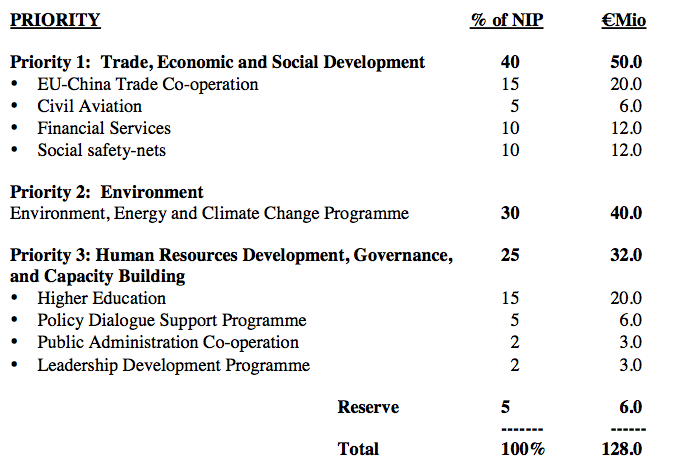
Figure 1: priorities for the budget for EU-China cooperation program (2007 - 2010)
From the breakdown of the EU’s budget for EU-China cooperation programs, one could easily see the dilemma for the EU in enhancing its profile in China. Given the fact that the nature of the EU as an actor with the Commission leading in the economic arena, the EU’s policies towards China themselves are largely in economic terms. Political and security matters concerning China will be handled by the EU Council of Ministers (and its Secretariat), which means that some of the more thorny and sensitive issues in the EU-China relationship are subject to the machinations of member state discussions. The challenge lies in the fact that the EU’s Member States are likely to pursue their own particular national economic interests in China.
Within such context, it would not be surprising for us to see that coverage on the EU in Chinese media is then dominated by economy and trade. This also raises naturally the question that whether the EU or its member states have higher profile in China and what is the EU’s power beyond the economic ones.
Important Differences in Norms and Values
The relationship between the EU and China is shaped by historical encounters, the nature of the two political systems and their interests in the international system. The EU envisions its role in the world very much as an international actor committed to the development of democracy, good governance, the rule of law and respect for human rights. The Treaty on the European Union states that “the Union is founded on the values of respect for human dignity, freedom, democracy, equality, the rule of law and respect for human rights, including the rights of persons belonging to minorities”.
However, China always puts sovereign rights ahead of individual rights. For example, Hu Jintao, in his speech marking the 30th anniversary of the reform and opening up, stated: “We should always adhere to the social system and development path that the Chinese people have chosen by themselves. We should always put the nation’s sovereignty and security above anything else. We should resolutely safeguard China’s interests in terms of sovereignty, security and development.”
Thus, while China emphasizes the sovereign independence and prioritizes economic development, the EU shows high-profile commitment to human rights and democracy both within and outside the Union. This difference in the recognition of individual rights versus sovereign rights has led to the inherent systematic reluctance by China to depict the EU from the perspective of human rights and the rule of law, which happen to serve as important principles in the EU’s external relations. This is also instrumental in understanding the news representation of the EU in China.
Another key difference is the growing emphasis on the domestic dimension for China’s external foreign policies, especially to ensure domestic stability. China is in the midst of its critical transition, politically, economically, and socially. Politically, China’s political reform has been stagnant for many years now. This is the crux of the intensification of all sorts of social conflicts across China, yet the authorities have absolutely refused to relinquish their monopoly on power. Besides, the future for democratization remains highly uncertain given the factional differences between the reform and conservative groups inside the communist regime. Economically, any reform in China’s economic sphere is bound to affect the interests of the power elite and monopolistic enterprises and disturb the foundation of the one-party system. Socially, the most prominent cause of China's social conflict has long been the pattern of severely unbalanced and unjust distribution of benefits. This has led to a situation where the people are moving backward while the nation advances, where the people are becoming poor while the officials become rich. In one word, the public’s need for reform is already urgent but all reforms are stagnant. This uncompromising conflict has made the central government put domestic stability as the highest of all the priorities of China. To achieve this, coverage on China as well as other nations would be tailored in a way where economic achievements are emphasized while other elements are downplayed or muted directly.
EU News in Chinese Media
The choice of newspaper was guided by a consideration of the targeted readership.
Sponsored by Xinhua News Agency, China’s official news agency, Xinhua Net releases news items 24 hours daily in eight languages, namely, Chinese (simplified and traditional), English, French, Spanish, Russian, Arabic, Japanese and Tibetan, by using multimedia communication means, such as texts, photos, graphics, audio messages, video, blogs, podcast, microblog, short messages, and cell phone news. It is also responsible for handling, and in some cases, censoring reports from foreign media destined to release in China. As a result, it can reach directly and instantly its audiences at home and abroad at crucial moments of major news coverage and breaking events.
The second paper is China Daily. Established in June 1981, it has the widest print circulation (over 500,000 per issue, of which a third is abroad) of any English-language newspaper in the country. The online website of China Daily, located at Chinadaily.com.cn, was established in December 1995, becoming one of the first major Chinese newspapers to have an online presence. The readership of China Daily is mainly foreigners and Chinese who seek to improve their English language skills.
Financial papers and magazines are purposefully excluded to guarantee a broader view of the Chinese perceptions of the EU instead of a narrow focus on the economic ties.
Volume of Coverage
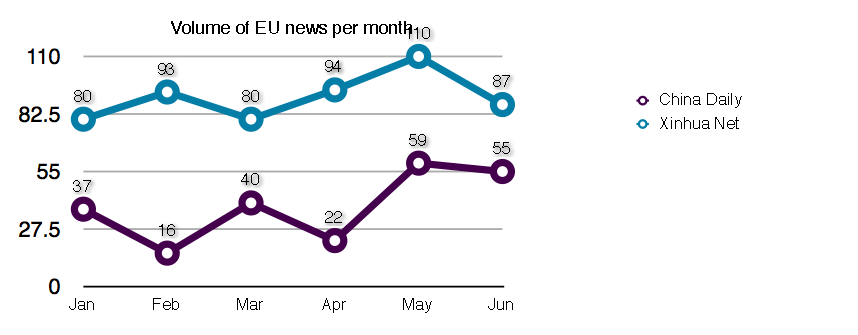
From Jan. 1st to Jun. 30th, 2011, a total of 773 news items with reference to the term “EU” are identified in the two media. China Daily contains 229 items while Xinhua Net has 544 items.
The amount of the EU news in Xinhua Net clearly doubles that of China Daily. Arguably, two reasons may account for this: first, Xinhua Net belongs to Xinhua News Agency, which has had contracts to exchange news and news pictures with more than eighty foreign news agencies or political news departments. The news source for Xinhua Net is more diverse than that of China Daily. Besides, as the major news source for Chinese domestic media, Xinhua is mandated to cover diverse news genres from economics, politics, society, and culture to fulfill the needs of various TV channels, newspaper, news websites and even magazines.
Despite the various numbers in each month, the peak of the EU news in both media is in May (169 items). Typical events reported in May include: The EU's high representative of foreign and security policy Catherine Ashton’s visit to the Libyan opposition party; the shift of the EU presidency; the Eurozone crisis and the bailout of Greece and Ireland; the celebration of Europe Day and China-EU Year of Youth.
EU News Section
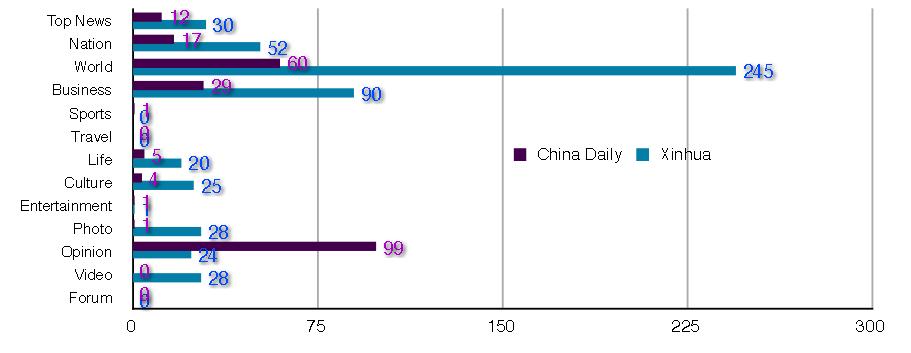
Three things should be noted in this category:
1) The surprising number of editorials and op-ed items on the EU in China Daily
Among the 229 EU news items in China Daily, 43 percent are editorial or op-ed items published in the Opinion section, while 26 percent are in World and 13 percent in Business.
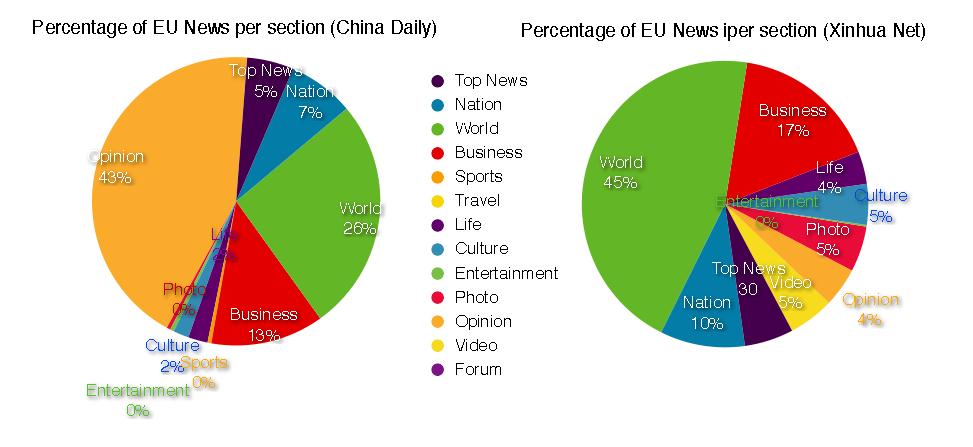
The most mentioned theme of the Opinion items on the EU is the analysis of the future path for EU-China relations from reviews of EU-China relations from a historical perspective. This theme is represented by the prevalent editorials and op-ed articles titled as “Fresh start to EU-China relations”, “A great opportunity for China and the EU”, “Moving forward together”, “Fruits of long-term friendship”, “Cooperate for better future” and so on. Forty-three percent of such items are written by EU-China experts from Chinese as well as European research institutes while around 45 percent are contributed by diplomats, especially by the European Union's ambassador to China and the China's ambassador to the European Union. Only around 10 percent are written by reporters or representatives from the business world.
Sub-themes under the theme of future EU-China relations include:
- China’s willingness to help the EU countries emerge from their financial difficulties could be a new start for their strategic relations;
- The significance of the EU and China in sharing responsibilities in a myriad of fronts, ranging from international security matters, such as the Iranian nuclear issue, counter-terrorism, and the fight against piracy, to global governance including the reform of the international monetary regime and climate change;
- The utilization of people-to-people exchanges to forge better understanding and a sense of closeness between the two peoples.
Such articles set an optimistic tone for the future of the EU-China relations by recognizing that the “EU-China relationship is comprehensive, strategic, dynamic and mutually beneficial and it is mature and solid enough to withstand tests and forge ahead.” However, few articles touch the nature of the EU and explain what the EU is to the Chinese public.
2) Uneven representation of soft and hard news on the EU
While the number of news items in each section in two media fluctuated from month to month, what is in common is the extremely low representation of the EU in “soft” sections such as Sports, Photo, Life, Entertainment, and Culture.
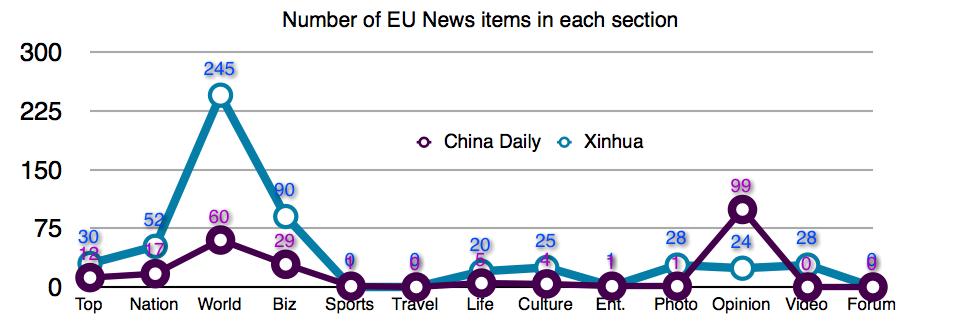
No news was published in the Travel section while only one item for Sports and one for the Entertainment section. Besides, only a small portion of the EU news (42/773) got on the front page in the Top News section, which was echoed by my next point on the marginalization of the EU news in Chinese media.
3) The marginalized representation of EU news in World news
What should be noted is that during the six months, the EU news only constituted 8 percent of all the news in the World section of China Daily. As for Xinhua Net, the EU news accounts for around 11 percent of the whole world news content. The other 80 percent of world news is centered on US-China relations and the relationship between China and its neighboring countries, Asian affairs, and the Middle East. Dominant topics include the nuclear issue in Iran as well as the Korean peninsula, and the Libyan situation. These statistics show that the EU news, despite the increasing amount as a whole, is still marginalized in Chinese media.
Focus of Domesticity
The focus of domesticity is identified in three aspects: 1) an “EU focused” angle, which means that the news focused solely on the events in the EU without any involvement of China; 2) a “local” angle, which means domestic news items with the inclusion of some information on the EU; 3) the “3rd party” angle, which refers to the EU news within the context of a third party (neither the EU, nor China), such as Libya, US, or the UN.
Through analysis, two media demonstrated two different patterns in domesticating the EU news. For China Daily, the EU news is most framed from the angle of “EU focused” (53 percent), which mainly covered themes such as Europe’s integration, the EU enlargement, and eastern European countries. More specifically, the EU focused news discussed issues such as “the dilemma of European identity” and “Europe at a crossroad”. Tones of such reports are objective and neutral, with frequent quotes from the EU experts on the advantages and disadvantages of EU expansion. Following is the “third party” angle (37 percent) with reference to Libya and UN. The least visible angle is the local one (10 percent), and topics for such reports mainly focus on food safety, environmental issues and climate change.
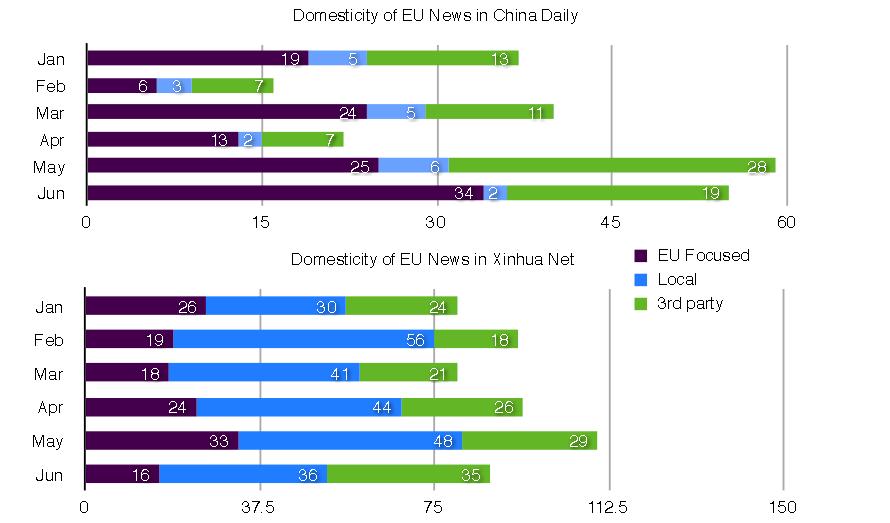
However, Xinhua Net demonstrated a different sequence in these three angles: 47 percent of the news is from the “local one” angle with key emphasis on an EU-US-China triangle. Following is an almost equal divide between the angle of “third party” (28 percent) and the angle of “EU focus” (25 percent).
Xinhua’s coverage, compared with those of China Daily, portrayed the EU as an international pole with strong relationship with China. The events and actions of the EU are localized to have the Chinese elements, thus turning the EU into a “zone of relevancy”.
The different level of domesticity also reflects the different readership of these two media. China Daily is mainly designed for educated and cosmopolitan group of locals to improve their English language skills as well as by foreigners learning about internal matters from the outside, so its representation of the EU is partially alienated from the local context, making the EU as an actor out there. However, Xinhua Net, with a varied readership from elites to general public, the EU news is more tailored in a way associated closely with China, with a broader emphasis on the EU as an active pole in the international arena.
Neutrality
This study used three indexes for the evaluations of the EU news, namely positive, neutral, and negative. The results showed that both China Daily and Xinhua Net adopted predominantly neutral evaluations of the EU (83 percent). Only 5 percent of the news items are negative, and the most dominated two negative topics are the EU’s tariff on imported Chinese cargo and arms embargo.
EU News Frames
The EU news items are categorized in three frames: politically, economically, and socially. Under each theme, several sub-themes are examined regarding the specific focus of the coverage.
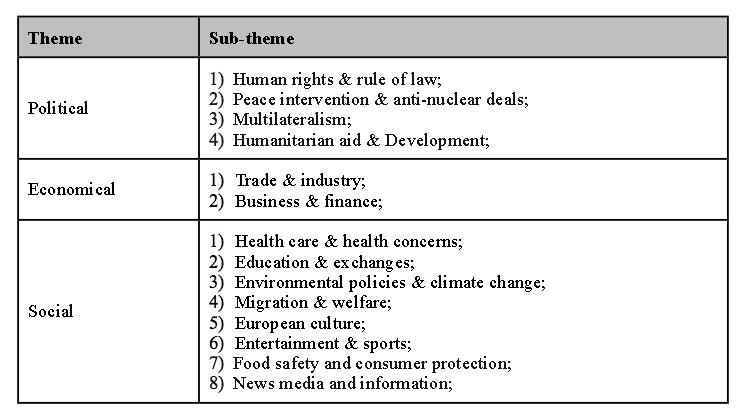
Despite the fact both media frame the EU primarily from the economical perspective, the detailed breakdown is very different.
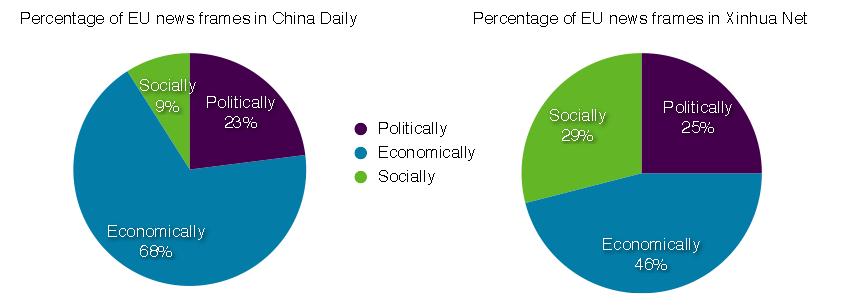
In China Daily, 68 percent of the news features the EU as an economic actor, and political actions are less visible but still constitutes an important portion (23 percent). The EU is almost invisible in its role in social affairs (9 percent), especially in the areas of environment, exchanges, and the diversity of culture. However, in Xinhua Net, even though the economical role of the EU is still prominent, the EU’s social and political roles are evenly seen in its portray.
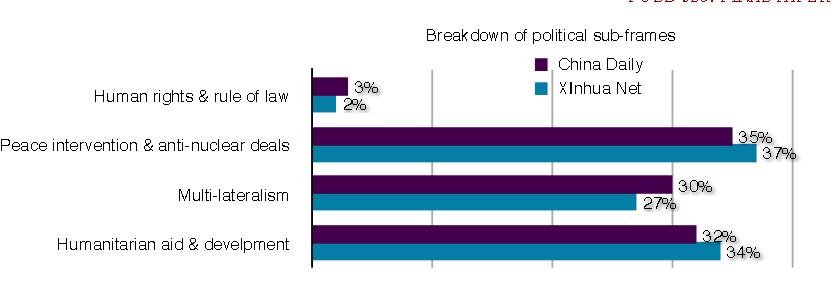
In seeing the EU in a political role, both media concentrated their attention on the EU as an external actor. Among its sub-themes, the most visible theme is “peace intervention and anti-nuclear deals”. Under this theme, the most reported incidents include:
- The EU’s intervention in Libya
- The EU’s negotiation process around Iran nuclear problem.
- The next most mentioned theme is “humanitarian aid and development”, under which the following incidents are most reported.
- The EU’s humanitarian aid to Japan in countering the nuclear crisis
- The EU’s humanitarian aid in the Horn of Africa nations;
- The EU’s humanitarian aid in Libya.
The third visible theme is multilateralism, in which relations between the EU and other “big players” such as US, Russia, Japan, and China. The relationship among the EU-US-China triangle is seen as the most important. For instance, Xinhua Net noted in the news on “International dialogues aim to promote positive images” that: "At a global level, European leaders have finally understood they inhabit a 'post-American world', and that strengthening ties with Beijing will provide leverage to gain a bigger say on the world stage.”
However, while China recognizes that the EU as a major strategic partner, it feels that the EU is lacking a strategic vision and suffers from internal discord, which impedes its credibility in world affairs. Europe simply does not exist as a political center of power, especially compared with the United States. For instance, in China Daily’s news “Cooperate for better future”, it is pointed out that: “The EU' relationships with China have been paradoxical. On the one hand, they like to criticize China. On the other, they find it hard to do without China, especially on the economic front...The EU needs to move beyond its paradoxical approach and work jointly with China to deepen cooperation and reduce differences.”
In terms of social power, the top two themes mentioned are exchanges and environment. Among the 773 news items, 177 news items are framed from the social power angle. However, among these 177 items, over 90 percent of the whole news are devoted to three specific incidents: 1) EU-China Year of Youth (35 percent); 2) The EU’s reaction to the breakout of E. Coli (18 percent); 3) The EU’s pushing for stronger global standards to ensure safety of nuclear power plants (37 percent). Other themes such as migration, welfare, multiculturalism, crime, as well as entertainment and sports reports are significantly less visible.
What should be noted regarding the EU-China Year of Youth is that according to the comments posted below Xinhua Net, this event turns out to be high-level with only a negligible number of people from both the EU and China involved. The wide public in China doesn’t have any knowledge of this project organized by Brussels and Beijing.

The Most Visible EU Actors
In terms of the EU institutions, the European Commission is the most visible with 78 references. The EC’s heightened profile was reflected in the coverage of both the EU’s internal and external affairs. Internally, the EU is most mentioned in the discussion of the EU enlargement, especially on the policy framework of Roma integration. It is also seen in news on Eurozone crisis. Externally, the EU’s role is promoted in areas of environmental protection (on the issues of clean energy and nuclear), and humanitarian aid in Libya and Africa as well as after the Japan and New Zealand earthquake.
As for the specific the EU representatives, the most mentioned official is Catherine Ashton, the EU’s High Representative for Foreign Affairs and Security Policy (47 references). Ashton is most mentioned in news on her trips to various countries including Libya, Tunisia, Egypt and other nations in the Middle East. Discourse around Ashton is centered on the EU’s commitment in providing humanitarian aid and in promoting the rule of law.
The next most visible EU actors are the President of the European Commission Jose Manuel Barroso (35 references) and the European Council President Herman Van Rompuy (35 references). Both of them are almost mentioned at the same time in news regarding the EU’s bi-lateral and multi-lateral events such as EU-Russia summit, EU-Africa summit, EU-Japan summit, and the EU's extraordinary summit on Libya issues. However, when dealing with Chinese issues, Rompuy is most mentioned while Barroso remained relatively invisible.
Of the 27 EU member states, Greece (64 references) was mentioned most due to its financial crisis and the bailout aid from the EU. The second most mentioned state is Germany (54 references). News on Germany mainly focused on 1) Germany, as China's largest trading partner in Europe, inked billion-dollar deals with China during the European trip of China’s Premier Wen Jiabao; 2) the outbreak of E. Coli in Germany; 3) the leading role of Germany in shutting down nuclear power plants.
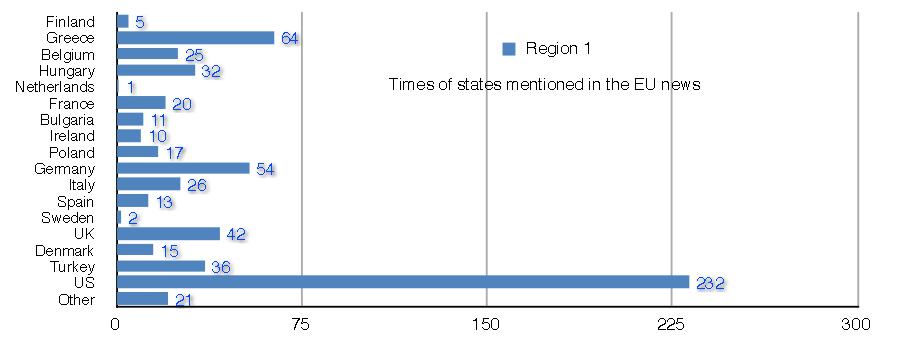
Among the big three, France has the least visibility. Besides, coverage on France has focused on France’s harsh stance on immigration. For instance, the news entitled “Italy, France ask EU to revise treaty” says that: “Italy and France have cast aside a bitter disagreement over immigration, agreeing to seek a revision of the Schengen border treaty that permits passport-free travel through Europe...France harshly criticized Italy for granting temporary residence permits to some 26,000 Tunisian migrants who have been arriving in Italy since January.”
Such coverage has reinforced the existing stereotype of the EU in China: EU as an entity with a role in the rise in racism and xenophobia, a major misconception the EU should constantly fight against.
The varied frequency of the EU states being mentioned in the EU news brings up one of the biggest difficulties for the EU in developing a positive and coherent international perception. As an evolving sui generis entity, the EU’s voice are compounded by media practice of relegating or glossing over the EU affairs ‘at the expense of more accessible national stories like the UK royal family, French culture and social issues, the quirkiness of Italy’s political system and so on’ (Saltmarch 2004).
Evaluation
The media representation of the EU in Chinese media suggests the following points:
- EU-China relations are still shadowed and constrained by the US-China relations, judged from the marginalized representation of EU news in Chinese media as well as the dominating focus on EU-US-China triangle;
- Within the limited EU news, the huge number of editorials on the EU and EU-China relations shows that China has had a clear understanding of the EU, in institutional terms and of its major member states;
- In general, the Chinese government supports a positive image of the EU in China;
- The EU’s image in Chinese media is diverse, although the political and economic attributes of the Union were stressed and social affairs of the EU is underplayed;
- However, uneven emphasis is found in the sub-themes of each category;
- Politically, the EU is most framed as humanitarian aid, anti-nuclear deals and its role in balancing the EU-US-China triangle;
- Economically, the EU as a whole matters increasingly for China in trade and other economic issues, while EU-China economic relations remain best defined in a bilateral framework with individual member states. Besides, the EU is recognized as China’s biggest economic partner but is still viewed negatively when it comes to issues on fair trade and arms embargo;
- Socially, the EU is most known for its commitment to environmental protection, especially on the issue of low carbon, clean energy and nuclear, while other aspects regarding immigration, health care, multiculturalism, and entertainment remain underplayed;
- The most cited sources for information on the EU are officials and diplomats from the Commission while the EU’s High Representative for Foreign Affairs and Security Policy tis taking the lead. This shows that the EU diplomats currently enjoy a good credibility in representing the EU, with an increasing need for the EU to strengthen its influence as an external actor, especially in the areas of foreign affairs and security policies;
Critics and Recommendations
In sharp contrast to the USA, which has been dubbed a ‘warrior state’, the emergence of the EU as a global actor has relied mainly on non-military tools to exert its influence and to maintain its visibility (Smith 2004a). The notion of a ‘soft’ or ‘civilian’ power refers to the EU’s preference for diplomacy and dialogue over peremptory military threats in pursuit of foreign policy aims. The conventional wisdom holds that the EU ‘may be more influential as a global actor by celebrating its differences with the USA and NATO rather than by attempting to imitate those actors’ (emphasis mine; Smith 2004b, p. 261; Lindberg 2004).
Within such context, the challenge for the EU is to maintain its strong economic and trading relationship with China while ensuring that any potentially divisive issues such as human rights, Tibet and Taiwan do not damage the development of these relations. As such, the EU and its member states should constantly encourage the private sectors as well as the non-governmental organizations to initiate in-depth dialogues on the sensitive and thorny aspects of China-Europe relations, such as human rights, environmental protection and climate change, energy security, the rule of law, and social welfare.
The EU should also engage the growing number of specialists on EU-China relations in the academic world since their opinions on the EU are most heard in Chinese media. By instructing their evolution, dynamics, and prospects, the EU could help shape the Chinese discourse on the EU.
What’s more, the EU should keep pushing to get its voice heard in Asia. The EU is investing an incredible amount of money in helping China’s social and economic transition, but such efforts are muted due to the lack of media exposure. The EU should exert more effort in getting its message out by telling people what the EU is doing and that the EU is doing well.
Last but not least, the EU should keep expanding people-to-people contacts and intercultural dialogue, especially among young people, in a number of highly interesting areas for future joint work: voluntary activities, active involvement in society and youth work, healthy lifestyles, creativity and international vision, employment and entrepreneurship.
References
Ash R, Shambaugh D, Takagi S (eds) (2007) China watching: perspectives from Europe, Japan and the United States. Routledge, London
Crossick, Stanley and Etienne Reuter, (eds.). 2007. China-EU: A Common Future. New Jersey: World Scientific.
El-Agraa A-M (2007) The EU/China relationship: not seeing eye to eye? Asia Eur J 5:193–215
European Commission (1995) A Long Term Policy for China-Europe Relations
Holland M, Ryan P, Nowak A, Chaban N (eds) (2007) The EU through the eyes of Asia: media, public and elite perceptions in China, Japan, Korea, Singapore and Thailand. Warsaw University Press, Warsaw
Li X (2007) Chinese television coverage and Chinese perceptions of Sino-EU relations. In: Kerr D, Liu F(eds) The international politics of EU–China relations. Oxford University Press, Oxford, pp 102–177
Smith M (2004a) Between two worlds? The European Union, the United States and world order. International Politics 21:95–117
Smith M (2004b) Europe’s foreign and security policy: the institutionalization of cooperation. Cambridge
University Press, Cambridge
Zhou H (2007) A Chinese perspective on Lisbon Strategy. Asia Eur J 5:357–365
Appendix I: Coding Sheet For Media Content Analysis on EU
A. DATE OF PUBLICATION: _____________________________________
B. HEADLINE: _____________________________________
C. SECTION:
- China
- US
- World
- Business
- Sports
- Travel
- Life
- Culture
- Entertainment
- Photo
- Opinion
- Video
- Forum
D. FORMAT:
- News report
- Editorial
- Column
- Op-ed
- Feature
- Cartoon/illustration
- Letter
- News Summary
- Review
- Others: _____
E. NEUTRALITY:
- For
- Against
- Neutral
F. THEME:
Theme: Political
Sub-themes:
- Human rights & rule of law;
- Peace intervention & anti-nuclear deals;
- Multi-multilateralism;
- Humanitarian aid & Development;
Theme: Economical
Sub-themes:
- Trade & industry;
- Business & finance; Social Affairs
- Health care & health concerns;
- Education & exchanges;
- Environmental policies & climate change;
- Migration & welfare;
- European culture;
- Entertainment & sports;
- Food safety and consumer protection;
- News media and information;
G. FOCUS OF DOMESTICITY
- Yes
- No
- Not applicable
H. STATES MENTIONED IN THE STORY:
Member States of the EU:
- Austria
- Greece
- Malta
- Finland
- Belgium
- Hungary
- Netherlands
- France
- Bulgaria
- Ireland
- Poland
- Germany
- Cyprus
- Italy
- Portugal
- Spain
- Czech Republic
- Latvia
- Romania
- Sweden
- Denmark
- Lithuania
- Slovakia
- United Kingdom
- Estonia
- Luxembourg
- Slovenia
Candidate countries: - Croatia
- Iceland
- Serbia
- Former Yugoslav Republic of Macedonia
- Turkey
- Montenegro
- US
- China
- Others
- Rest of the World
- NA
- I. SOURCES QUOTED:
- Not applicable
- Law and order
- Sport
- Military
- Academy
- Intelligence
- Monarchy
- Trade Union
- Witness
- Medical
- Religion (church)
- Terrorist group
- Government agency
- Civil servants
- Diplomats
- Media
- Business
- Economic & financial experts
- NGO / Social Movement
- Think tank
- Persons / Citizens / Groups
- Showbiz
- Sci/tech







